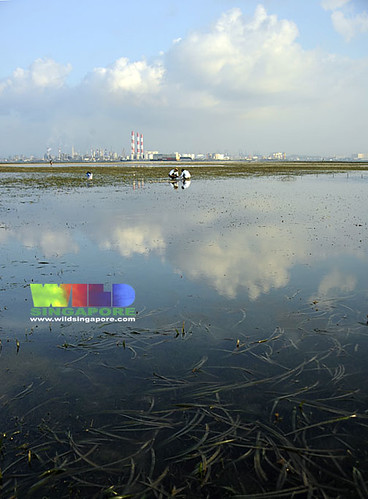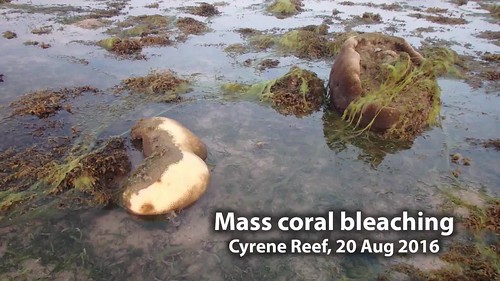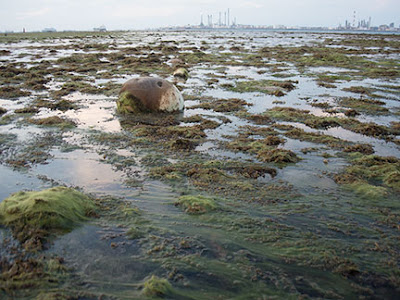Today, from observations by the team, we estimate about 30-50% of hard corals are still bleaching, while only about 10-20% of leathery soft corals were bleaching. But, I sense about 20% of the hard corals have died. The shore is very much alive though. The rest of the team saw amazing animals such as another live Cone snail!
Here's a video of the mass coral bleaching I saw today.
Here's a video of the mass coral bleaching I saw in June 2016
Mass coral bleaching in Singapore should be ending. From the NOAA's coral reef watch satellite monitoring, Singapore is in the blue Watch zone. It sure is taking a long time for our corals to recover. I hope they can recover before they die. Sigh.
What is coral bleaching?
Coral are colonies of tiny animals called polyps. Each polyp lives inside a little hard skeleton. The huge colony is made up of the skeletons of countless polyps. The polyps of all reef-building hard corals harbour microscopic, single-celled algae (called zooxanthellae). The polyp provides the zooxanthellae with shelter and minerals. The zooxanthellae carry out photosynthesis inside the polyp and share the food produced with the polyp. Corals generally have white colour skeletons, which is believed to assist in photosynthensis by reflecting light onto the zooxanthellae.
When there is massive loss of zooxanthellae in a hard coral colony, the polyps become colourless and the underlying white skeleton shows through. Thus patches of the colony appear pale, white or 'bleached'. The polyps are still alive and the hard coral is not dead (yet).
Without the food provided by the lost zooxanthellae, the polyps will be stressed and prone to diseases. Skeleton production and reproduction are also affected. Once the cause of bleaching is removed, however, polyps may eventually regain zooxanthellae (which live freely in the water) and thus recover their health. But prolonged bleaching can kill corals and seriously damage large sections of a reef.
Factors believed to cause bleaching include: temperature fluctuations (too high or too low), excessive exposure to ultraviolet light, excessive sedimentation in the water, changes in salinity and disease. It is generally believed that bleaching is related to unusual prolonged temperature increases in the seawater. Hard corals harbouring zooxanthellae live close to the upper limit of temperature tolerance. Thus a temperature increase of even 1-2 degrees centigrade can redult in bleaching. It is believed that global warming will lead to massive bleaching.
Almost the entire reef flat is now covered with a bloom of very long growth of Bee hoon seaweed entangled in Sargassum seaweed that is starting to bloom as well. This made it difficult for me to cover the same area I did two months ago in June 2016 when we first observed mass coral bleaching on this shore.
The seaweeds also covered much of the hard and soft corals, so it was difficult to estimate how much were still bleaching.
In the short survey covering a small area of the reef, I saw some small colonies of corals that were not bleaching: Cauliflower corals, Boulder pore corals, Branching Montipora corals, Merulinid corals. But I did not see any of these corals that I saw on our trip 2 months ago: Brain corals, Anemone corals, Small goniopora corals, Flowery disk corals or Asparagus flowery soft corals.
I did manage to get to some of the corals that we saw previously. This one is still bleaching and it appears about 30% of one side of the coral had died.
Here's what this coral looked like in two months ago when we first observed mass coral bleaching this year on Cyrene Reef.
Most of the large bleaching corals had brown patches. Signs of recovery?
Some of the hard corals were all brown but had slimy patches. I'm not sure what is going on.
Animals that contain symbiotic algae also bleach. These include sea anemones. All the Haddon's carpet anemones I saw were not bleaching. I saw one bleaching Giant carpet anemone and another not bleaching. Russel saw one bleaching Snaky anemone. I didn't see any Frilly anemones. I didn't see any symbiotic fish or shrimps in the anemones.
It was rather disconcerting to come across many White sea urchins that look like they were dying with spines falling off and large patches on their body bare of spines. I'm not sure if is just the end of their 'season' or a sign of something else.
Cyrene is not just a reef. It also has vast seagrass meadows, probably among the best in Singapore. I managed a quick look at the deep pool which used to have long Tape seagrasses. The base of the pool is now completely covered with lush growths of shorter species of seagrasses.
But the Tape seagrasses here are still cropped short. Elsewhere on the shore, I saw some clumps of longer Tape seagrass (more than 30cm long). So hopefully, things are coming back to normal.
Here's what the pool looked like at its best in Jun 2009, with Jeff and Collin of NParks doing a survey of the abundant variety of fishesfound in the pool. Most of the seagrasses died out in May 2012, leaving the pool with bare sand. We first started seeing a recovery in Dec 2015. Let's hope the recovery continues and this pool returns to its former glory.

Another positive development, the huge crater near the reefy area that looks like it was cause by a boat striking the reef, is now starting to fill up with seagrasses.
Here's a look at the base of what used to be bare sand. Today, I noticed a lot of white ascidians growing on the seagrasses. I only spotted one Vermillion flatworm. The Slender pom-pom seaweeds are also abundant.
Knobbly sea stars remain abundant on Cyrene. Including small ones, which shows that the population on the reef is self sustaining. Common sea stars were also plentiful, many in 'mating position'.

Fortunately, it looks like a rather 'clean' burn with little smoke being produced.
Alas, at the petrochemical plants on Pulau Bukom, there was black smoke being produced. I'm not sure whether it's from the vessel or the petrochemical plants.
Fortunately, today we did not come across any fish traps and did not see people laying traps near the reef.
High res photos of mass coral bleaching in Singapore for free download on wildsingapore flickr
Posts by others on this trip
- Russel Low on facebook.
- Jianlin Liu on facebook.
- Marcus Ng on facebook.
- Sam Yeo on facebook.



























